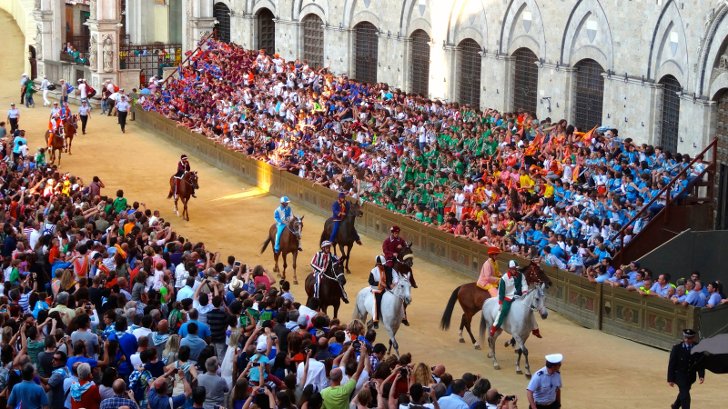The term “palio” refers to annual athletic contests held throughout Italy. Such contests often have a historical character and involve neighbourhoods of a town or settlements of a comune competing against each other in horse or donkey racing, archery, crossbow shooting, jousting, and other medieval sports.
Although the Palio di Siena isn’t the longest-running palio (that would be the Palio di Ferrara), it is probably the best known internationally. It stems from the 16th century bullfights. When Ferdinando I de' Medici, Grand Duke of Tuscany outlawed bullfighting in 1590, it was replaced by buffalo-back and donkey-back racing in the Piazza del Campo. The first modern type palio took place in 1633.
The Palio di Siena was originally held once a year, on July 2. A second race in August was added in 1701. It was held irregularly at first because the August race was organized and funded by the winning neighborhood (contrada). If the contrada in question couldn’t afford it, the second race was canceled. Since 1802, the August race has been organized annually by the city.
The July Palio is referred to as Palio di Provenzano in honor of the Madonna of Provenzano. The August Palio is known as Palio dell’Assunta because it is held near the Feast of the Assumption of Mary (Assunzione di Maria). Sometimes an extraordinary Palio is held to celebrate a special event. The last one was held in 2000 in honor of the beginning of the new millennium.
The city of Siena consists of seventeen contrade (districts) but only ten of the seventeen contrade participate in each race: the seven which didn’t participate in the previous Palio plus three chosen by drawing lots. Each contrada of Siena is named after an animal or symbol and has a long history and its own heraldic symbol and colors.
The race is preceded by the Corteo Storico, a historical costume parade in the Piazza del Campo. The parade features representatives of the contrade wearing their signature colors, standard-bearers, musicians, and costumed characters in medieval clothes.
The race itself starts at 7:30 p.m. for the July Palio, and 7 p.m. for the August Palio. Ten jockeys, riding horses bareback, make three laps around the Piazza del Campo, each lap about 333 meters long. The perimeter of the piazza is covered with a layer of tuff, clay and sand, and protected with padded crash barriers specifically for the event. The race takes about 75 to 90 seconds to complete.
The Palio di Siena is more than just a horse race. It is the culmination of the rivalry between the contrade that has been going on for centuries. The Palio is associated with historical alliances and animosities, intricate strategies, and numerous rituals that make it really special.

Photo: everfest.com
